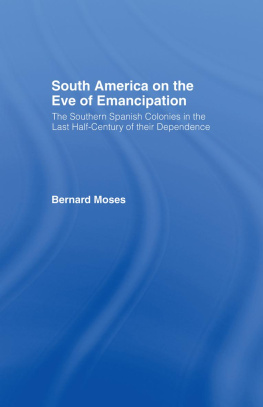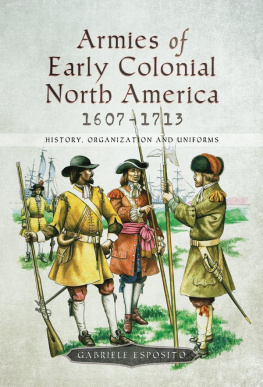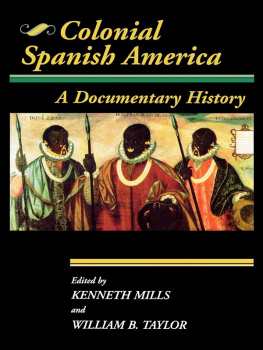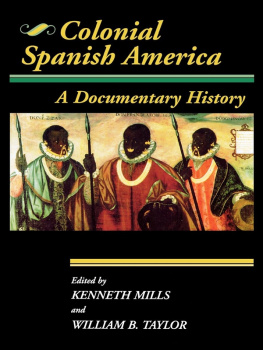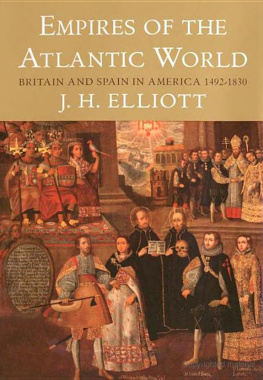First published 1965 by
Cooper Square Publishers, Inc.
Published 2013 by Routledge
2 Park Square, Milton Park, Abingdon, Oxon OX14 4RN
711 Third Avenue, New York, NY, 10017, USA
Routledge is an imprint of the Taylor & Francis Group, an informa business
ISBN 13: 978-0-714-62032-9 (hbk)
Publishers Note
The publisher has gone to great lengths to ensure the quality of this reprint but points out that some imperfections in the original may be apparent
PREFACE
I N a book called The Establishment of Spanish Rule in America, published in 1898, the present writer gave some account of the origin and earlier history of the institutions framed for the government of Spanish America. This volume aims to present some phases of colonial history and social organization in the last part of the eightteenth century, particularly as they appear in the southern half of South America. The annals of the colonies furnish interesting episodes, but not material for a sustained dramatic narrative. There are periods in the history of some of the colonies, during which one observes few social changes. Men live as their fathers lived and die as their fathers died; and the history of their communities for generations may be told in a few sentences. In attempting to make a connected story of the events of these periods, a writer runs the risk of producing merely a chronicle, or of doing violence to the perspective of time. The task here undertaken is to present certain conspicuous events, institutions, and phases of life, that may illustrate the state of the southern Spanish colonies on the eve of the revolution which gave them independence.
Many of the statements of-these chapters apply generally to Spains possessions in America. But the physical environment of the colonies within the tropics made prominent certain features of social growth unlike those which appeared in the temperate regions. The state of society in the northern part of South America, during the later decades of the colonial period, is thus a subject by itself, and is put aside for another volume.
B. M.
UNIVERSITY OF CALIFORNIA,
April, 1908.
SOUTH AMERICA ON THE EVE OF EMANCIPATION
THE CAPITAL OF SOUTH AMERICA
T HE Spanish colonial settlements established within the limits of the territory now claimed by the republics of Argentine, Bolivia, Chile, and Paraguay, were politically subordinated to the viceroy of Peru during their first two hundred years. In fact, down to nearly the middle of the eighteenth century all the territory under Spanish rule in South America was subject to this authority. The political centre, the capital in which resided the government recognized throughout this vast domain, was the city of Lima. By the final establishment of the viceroyalty of Santa F, in 1739, the northwestern part of this territory was brought under a new viceroy. The southeastern part of the continent continued under the jurisdiction of the viceroy of Peru, until 1776, when the viceroyalty of Rio de la Plata was created. This distribution of territory was modified in 1796, by withdrawing certain districts northwest of Lake Titicaca from the viceroyalty of Rio de La Plata and adding them to the viceroyalty of Peru. In 1802 Peru acquired from the viceroyalty of Santa F the districts of Maynas and Quijos, except the town of Papallacta; and, in 1804, it was determined that the provinces of Guayaquil and Chilo should be subject to the government of Lima. In 1810 Peru embraced eight intendancies: Lima, Tarma, Cuzco, Huancavelica, Huamanga, Arequipa, Trujillo, and Puno; its control extended also over the detached governments of Guayaquil, Chilo, Maynas, Quijos, Huarochir, and Callao. Guayaquil subsequently became independent and Chilo was added to the republic of Chile.
As the residence of the highest political and ecclesiastical authorities of South America, Lima acquired many of the features of an old-world capital. All persons wishing to achieve social distinction, and all persons who had achieved such distinction, found it desirable to live in Lima. The presence of the highest officers of the government and the dignitaries of the Church made it the social centre of South America.
In Mexico the Spaniards established their capital at the centre of the dominant Indian community. To have followed this example in Peru would have placed the new city at an inconvenient elevation, and in a position difficult of access from the sea. In Mexico the Spaniards wished to get away from the unhealthful coast. In Peru the valley of the Rimac near the coast offered an agreeable and healthful climate and an abundance of pure water for the uses of a city and for irrigation in a rainless region. Lima was, therefore, founded here in January, 1535. At the close of the eighteenth century, when Tadeo Hanke wrote his description of the city, it was surrounded by walls, which had been built as a means of defence against attacks of pirates. The inhabitants had been especially aroused to undertake this work by the report of the sacking of Vera Cruz, in 1683. Previously they had exhausted their energies in the fruitless discussion of various projects; but this event turned their efforts to practical action. In October of this year, the viceroy, the Duke of La Palata, wrote to the cabildo, or ayuntamiento, of Lima, and asked it to consider the question of building the proposed wall, and to decide what means for carrying on the work would be the least burdensome. He wrote also to the consulado, the university, the religious orders, and to various other organizations. After these negotiations it was finally determined how much each association should pay, or what part of the wall it should build, and what tax should be levied on certain wares in order to secure the funds necessary for the undertaking.1 The writer of A True and Particular Relation of the Dreadful Earthquake of 1746 says that these walls were between eighteen and twenty-five feet high; that there was neither ditch nor outworks; and that they were built by a Flemish priest, whose name was Don John Ramond.2
At the beginning of the eighteenth century Lima had about 30,000 inhabitants. In 1764 there were 54,000; and the population is estimated to have increased in the following years so that it amounted to 87,000 in 1810. Of the latter number, 20,000 were whites, while the rest were Indians, negroes, and various classes of mixed blood. The city was about a mile in extent from north to south, and about the same extent from east to west. It was divided into two parts by the river Rimac. Communication between these two parts passed over the stone bridge which was built during the administration of Montes Claros. At first there was a wooden bridge, and later the Marquis of Caete, while viceroy, caused a bridge to be constructed of brick near the site of the present stone bridge. This was built with seven arches, and was subsequently destroyed by the force of the water. After its destruction several years passed before the present structure was undertaken. It was, however, finally begun in 1608, and completed in 1610. The plans were made by Friar Geronimo Villegas, a native of Lima, and the work was carried on under the direction of Don Juan del Corral. The expenses of the construction were met in part by a tax of two reals on every sheep consumed, and by certain contributions required of other cities in the viceroyalty. Some of these were unable to see any evidence of justice in being required to pay for work that lay entirely beyond the limits of their jurisdiction; and Quito, in particular, complained at being compelled to furnish this assistance. The total cost of the structure, including the replacing of the arch that was thrown down by the earthquake of 1746, was seven hundred thousand pesos. The bridge rests on five stone arches.

